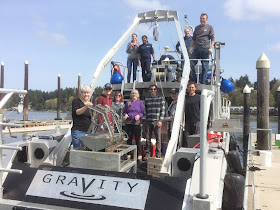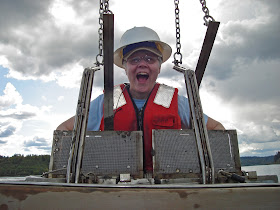 |
Shakedown! The whole crew meets on the first day to make sure everything goes smoothly while sampling Budd Inlet, our closest station to
home.
|
Mudslingers
Many months of logistical planning go into every field season (read our new sampling plan). Federal, state, county, and tribal collecting permits need to be approved, supplies have to be ordered, and the boat and crew must be scheduled. Our sampling itinerary has to be flexible because unpredictable Washington spring weather can cause unexpected changes and delays.
 |
Angela gets ready to sample at a new station by labeling jars
and recording data.
|
Taking it outside
BEEP! BEEP! BEEP! A typical field day starts with the unwelcome sound of an alarm clock at 4:45 a.m. The crew meets at the crack of dawn because field days can be long – sometimes 12+ hours. We need plenty of time to collect sediment from multiple locations throughout the Sound. Some of our stations are up to 230 meters deep. Plus, we have I-5 traffic on the way back to the lab.
Before the boat hits the water on the first day, our team meets to go over safety protocols
 |
| Maggie celebrates the collection of a successful benthic grab. |
Bottoms up
At each station, we use a powerful winch to lower our Van Veen grab to the bottom, where it snaps closed, trapping a sediment sample (hopefully full of critters) inside. Once on deck, we take a few measurements, then empty the entire contents of the grab sample into a sieving tray. The sample is gently rinsed to remove fine particles, retaining any critters living there.
These samples will later be sorted and identified in the lab (that’s where we taxonomists come in).
When we collect mud, we don’t just look at the animals. We also send mud samples to Ecology’s Manchester Environmental Laboratory to be analyzed for grain size, nutrients, and a suite of 80+ chemicals such as hydrocarbons, PCBs, and metals. These parameters help us understand how the condition of the habitat affects the benthic communities that live there, and gives us a more complete picture of Puget Sound sediment quality. We also provide samples for other research projects, including microplastics, harmful algal blooms, and even tinier benthic critters (foraminiferans, or “forams”) which give views into effects of hypoxia and ocean acidification.
 |
| Left: Sandy carefully fills jars with mud to send off to Ecology’s Manchester Lab. Right: Angela and Dany only get out the lab a couple of weeks a year, and love every minute of the work. |
The great outdoors
Although sampling can be exhausting, we love our field days because they remind us of the beautiful Puget Sound environment we are working to protect. Our favorite days are when the sun is out and we are sandwiched between the snowy Olympics on one side of the boat and the majestic Cascades on the other. It truly is a magical place to live and work!
 |
| Whew! Sampling is hard work, with little time for breaks. These early risers relax for a moment between stations to soak up a few fleeting rays of sunshine. |
By Dany Burgess and Angela Eagleston, Environmental Assessment Program
Critter of the Month
Our benthic taxonomists, Dany and Angela, are scientists who identify and count the benthic (sediment-dwelling) organisms in our samples as part of our Marine Sediment Monitoring Program. We are tracking the numbers and types of species we see in order to understand the health of Puget Sound and to detect any changes over time.
Dany and Angela share their discoveries by bringing us a Benthic Critter of the Month. These posts will give you a peek into the life of Puget Sound’s least-known inhabitants. We’ll share details on identification, habitat, life history, and the role each critter plays in the sediment community. Can't get enough benthos? See photos from our Eyes Under Puget Sound collection on Flickr.


No comments:
Post a Comment
We will not post comments with links to commercial sites, so please do not include them! Thank you.
(Comments Policy)